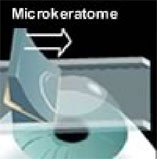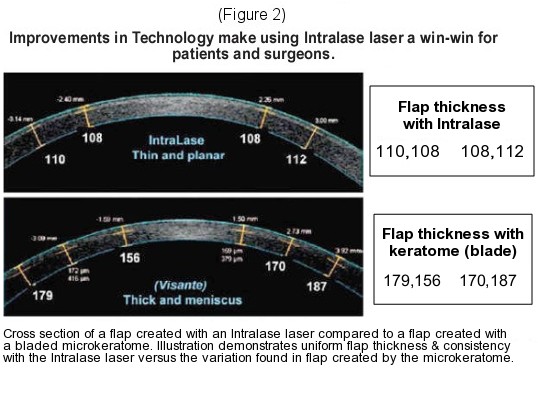Step One of LASIK surgery is the creation of the corneal flap. This step can be performed with or without a blade.
See why Dr. Cassidy chooses bladeless eye surgery with IntraLase technology
Bladeless Eye Surgery is important to faster healing, greater comfort and better vision.
We are one of a few select LASIK centers in Arizona that offer the most advanced upgraded Fifth Generation IntraLase, also referred to as the IntraLase iFS Advanced Femtosecond Laser System. This is an integral part of the iLASIK procedure. Many LASIK centers that use IntraLase offer Fourth Generation Technology.
Clinical experience and scientific studies have shown that some of the special benefits of the Fifth Generation iFS System over Fourth Generation technology include;
- Better patient comfort during the procedure, because the flap is created faster. This results in a shorter intra operative pressure sensation on the eye.
- The flap heals more rapidly and is stronger, due to the unique flap design. This results in faster visual recovery and enhanced safety profile.
- Patients experience less dry eye symptoms, also due to the unique flap design. This is related to the the faster return of normal corneal sensation with the associated natural blink reflex.
- The ability to not only change the size and thickness of the flap, but also change the shape, to enable customize treatment according to each patient’s needs. The iFS system is also capable of performing other specialized corneal procedures.
The IntraLase laser is a more precise and safer method for creating the flap in Step One and is an essential component to making LASIK surgery better.
Every cornea is different. Every corneal flap is different, too. But there are certain characteristics that every flap must have, including precise diameter, centration and thickness, thereby setting the stage for your doctor to perform an excellent Step Two.
 Traditionally, doctors have used a noisy mechanical procedure to create the flap. In this method, the doctor cuts across the cornea using a hand-held microkeratome with an oscillating blade. Achieving accurate depth, flap thickness, and centration on a curved cornea of varying dimension can be difficult with a microkeratomeThe precision of this step is highly dependent upon the performance of the microkeratome device, which may be unpredictable despite a high degree of surgeon skill.
Traditionally, doctors have used a noisy mechanical procedure to create the flap. In this method, the doctor cuts across the cornea using a hand-held microkeratome with an oscillating blade. Achieving accurate depth, flap thickness, and centration on a curved cornea of varying dimension can be difficult with a microkeratomeThe precision of this step is highly dependent upon the performance of the microkeratome device, which may be unpredictable despite a high degree of surgeon skill.
Creating the Laser Flap
The IntraLase laser actually represents a breakthrough in the field of ultra fast laser science. Generating light pulses as short as one-quadrillionth of a second, femtosecond laser technology has opened new fields of scientific study and provided the basis of femtochemistry research that won the 1999 Nobel Prize in Chemistry.
The use of the femtosecond laser in the field of Ophthalmology was developed by a team of Physicists, Biomedical Engineers and Ophthalmologists at the Center for Ultra fast Optical Sciences and the Kellogg Eye Center of the University of Michigan.
The IntraLase ultrafast femtosecond laser is the first bladeless laser technology for performing Step One of LASIK and the most accurate technology for corneal flap creation available today. The laser uses an infrared beam of light to precisely separate tissue through a process called photo disruption. In this process, the focused laser pulses divide material at the molecular level without the transfer of heat or impact to the surrounding tissue.
- IntraLase creates the flap from below the surface of the cornea, using an “inside-out” process.
- The silent beam of laser light is focused to a precise point within the stroma (central layer of the cornea) where each pulse of the laser creates a tiny 2-to-3 micron bubble of carbon dioxide and water vapor.
- Thousands of these microscopic bubbles are precisely positioned to define the flap’s dimensions, as well as the location of the hinge.
- Bubbles are then stacked along the edge of the flap up to the corneal surface to complete the flap.
- The process from start to finish takes approximately 30 seconds.
- The surgeon then lifts the flap to allow for treatment by the excimer. When treatment is complete, the flap is repositioned.
With IntraLase, your doctor can create a corneal flap of exact diameter, depth, hinge location, centration, and overall architecture. Such accuracy and precision are nearly impossible in a hand-held blade.
Making LASIK Better
IntraLase creates a flap of precise size, shape and depth. To achieve such precision, your doctor uses the laser to rapidly separate micro-thin layers of the cornea as he creates a self-sealing flap. It is all a part of an efficient process that helps to assure you that Step One of LASIK eye surgery will be accurate, safe and a first step towards giving you the best LASIK result possible.
Safety, predictability, and control make the IntraLase laser, for flap creation, the choice of Moretsky Cassidy Vision Correction
For outstanding safety and effectiveness, Navy aviators may now receive “the best of the best” LASIK, which is offered at Navy Medical Centers. It includes the creation of the LASIK flap with IntraLase and correction of their refractive error with Custom (WaveFront Guided) treatment (iLASIK). Navy Aviators can now enjoy faster visual recovery with quicker return to flight duty. In the past, Navy Aviators could receive laser vision correction, but using surface treatment (PRK). The recovery was slow and downtime of up to several months was required. PRK is still available, but is being replaced with IntraLase Custom iLASIK.
National Aeronautics and Space Agency (NASA) approves iLASIK for use on astronauts and astronaut candidates. NASA’s decision was made following review of extensive military clinical data, using “all laser” LASIK, with IntraLase flap and Custom treatment, which showed that this combination of technology provided outstanding safety and vision. NASA’s revised refractive surgery protocol follows similar moves by the Air Force and Navy, regarding their eyesight standards for pilots. The exact visual standards required by NASA have long been a number one disqualifying factor for astronauts or astronaut candidates. It was not until IntraLase flaps, with Custom treatment, that NASA approved this procedure.
In a recent study the IntraLase flap associated with Custom treatment (iLASIK) had improved clinical results. Specifically faster visual recovery with better contrast and better night vision qualities when compared to mechanical or bladed keratome flaps with the same Custom treatment. This is why LASIK with the bladed keratome is not approved by NASA.

More Accurate Flap Information
The advent of the Intralase femtosecond laser, allows our surgeons to program a flap’s thickness and actually customize the configuration of the flap’s edges from a centralized control screen before ever initiating the actual process of creating the flap.
Because the Intralase laser focuses its energy on a specific area or plane of the cornea, the thickness of the flap it creates does not depend on a bladed device’s translation speed across the cornea, corneal curvature or corneal thickness, all of which affect the shape and thickness of flaps created with mechanical microkeratome blades.
Compared with mechanical microkeratome blades, the Intralase laser offers more options for customizing the diameter, shape, orientation and position of the flap during LASIK surgery. Additionally the treatment ablation (tissue removal) strategy can be individualized based on different corneal anatomies and structures. The Intralase is better at creating thin flaps than mechanical microkeratome blades thus leaving stronger residual cornea and preserving more sensation which stimulates blinking and reduces dry eye symptoms. See figure #1 and figure #2.

Read about Part 2 of Bladeless Eye Surgery with CustomVue Technology

